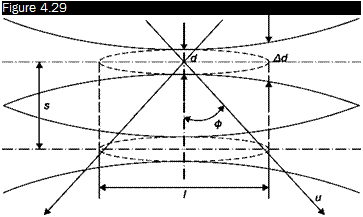Measurement volume
Each of the two ideal measurement volumes can be defined as that zone of the focus contained within the surface on which the light intensity is equal to 1/e2 of its maximum value: if the intensity distribution of a laser beam is Gaussian, the surface will be an ellipsoid (Figure 4.29a). The real measurement volume is the undefined region from which the scattered light is projected onto each photomultiplier.
To properly define the boundaries of the measurement volume, the scattered light coming back towards the detectors is filtered through calibrated holes that allow only the passage of light from a narrow
Measurement volume of L2F: (a) in the plane of the laser beams; (b) in the normal plane

 (a)
(a)
(b) region, which is the real measurement volume. The ability to operate on the signal, setting the threshold level and allowing the passage only to signals of certain characteristics, increases the definition of the measurement zone, making it very close to the theoretical one, for example, very weak signals are typical of light scattered by particles crossing laser beams in areas different from the focus.
The diameter d of the spots in the area of measurement is about 10 pm, the distance s between the two is about 102 pm (remember that the size of the spot of an LDA is of the order of 1 mm). If the distance l » 2s, the angle ф shown in Figure 4.29a is 45°. Note in Figure 4.29b that the finite diameter of the spot induces uncertainty about the exact distance traveled by the particle. Figure 4.29b shows that start and stop pulses can be generated by particles traveling either according to the line joining the axes of two laser beams or, at worst, according to the tangent at the bottom left and top right of the beams. The maximum relative error is:
є =——– = 1 – cos I sin 1
s
The error decreases as the ratio s/d. On the other hand, the probability of two related events decreases when this ratio increases.











